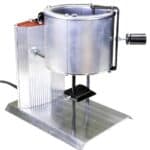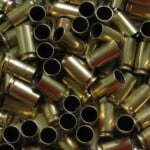
Introduction to brass trimming
Brass trimming refers to the process of cutting back spent brass shell casings (often from centerfire rifle rounds) to the correct length for safe and effective reloading. This is a crucial step in the reloading process, as firing a round can cause the brass to stretch, and if left unchecked, this could potentially lead to issues like overpressure and feeding problems.
Although trimming is most commonly done as part of the reloading process (especially for rifle rounds), brass trimming is also use for converting brass from one caliber to another, a technique that is sometimes used to produce brass for obsolete or obscure calibers. Sometimes it's used just to convert more commonly available brass, such as converting .223 to .300 BLK.
For either case, reloading or conversion, the procedures, tools, and considerations are nearly identical.
Trimming as part of brass conversion
Trimming brass cases is a crucial step in the process of converting one cartridge type to another, particularly when the new cartridge is shorter than the original. Failing to trim brass cases to the proper length can result in a number of problems, such as chambering issues, poor bullet seating, and inconsistent ignition, all of which could lead to diminished accuracy and potentially unsafe shooting conditions. Before starting any conversion, one must have comprehensive knowledge of the dimensions of the original and target cartridges. This will help in determining whether trimming is necessary and to what length the brass should be trimmed.
Tools
Brass trimming can be performed using various tools, such as manual case trimmers, lathe-style trimmers, or even specialized attachments for electric drills. For the highest degree of precision, a lathe-style trimmer is often recommended. In these devices, the brass case is typically held stationary, while a spinning cutter removes material from the case mouth until it reaches the correct length. On the other hand, manual case trimmers are less expensive and can also yield good results when used correctly. For quick, high-volume trimming, drill attachments can also be used, although they generally offer less precision than the other methods.
Before you begin the trimming process, it’s crucial to prepare the brass cases. This includes removing any spent primers and cleaning the cases to remove soot, dirt, or grease. Depriming is usually done using a universal deprimer or as part of the resizing process. Cleaning can be done using various methods, such as tumbling in a brass cleaner or ultrasonic cleaning. After the cases are cleaned and deprimed, the next step is to resize them. Resizing ensures that the brass fits properly in the chamber of the firearm for which it is intended. It is usually done using a resizing die that reshapes the brass case to its original dimensions.
Once the cases are prepared, they are ready for trimming. If you are using a manual or lathe-style trimmer, the process often involves inserting the case into the holder and locking it in place. The trimmer’s cutter is then adjusted to the required length based on the specifications of the target cartridge. Some trimmers come with preset stops or gauges to make this process easier. The case is then rotated while the cutter removes material from the case mouth. After trimming, the case should be measured using a caliper to ensure that it meets the required length. Cases that are too long or too short will need to be discarded or re-trimmed.
Preparation
Following trimming, the cases often have sharp or uneven edges around the case mouth. This can interfere with bullet seating and may even damage the bullet. To resolve this issue, the trimmed cases should go through a deburring process to remove any rough or sharp edges. Deburring tools usually have conical or chamfered ends and can be manually rotated around the inside and outside of the case mouth to remove burrs and smooth the surface. Some advanced trimmers have built-in deburring tools, making this step more streamlined.
Additionally, after trimming and deburring, it’s good practice to inspect each case for signs of fatigue or other defects. Look for any cracks, especially near the case head, as these are potential weak points that could result in case failure during firing. Any cases showing signs of fatigue should be discarded immediately.
Safety
Trimming brass for cartridge conversions is an integral part of ammunition reloading and is crucial for safety and performance. The steps involved, from preparation to trimming and deburring, require careful attention to detail. This ensures that the reloaded or converted ammunition is both safe to use and performs as expected. Proper measurement tools like calipers, and quality trimmers and deburring tools, are essential for achieving accurate and consistent results. By adhering to the dimensions specified for the target cartridge and by following a meticulous procedure, cartridge conversion can be carried out effectively.
Here's a simplified step-by-step guide on how to trim brass:
- Measure Your Brass: Use a caliper to measure the length of your brass. Compare this measurement with the recommended length for your specific caliber (which can usually be found in a reloading manual). Remember, each cartridge has a specific trim-to length.
- Set Up Your Brass Trimmer: There are various types of brass trimmers, from hand-operated to bench-mounted to motorized models. Make sure you adjust your trimmer according to the desired length of the brass. Each trimmer is slightly different, so consult the manufacturer's instructions for your specific model.
- Insert Your Brass: With your brass trimmer set to the correct length, insert your spent casing into the trimmer.
- Trim the Brass: Rotate the shell against the cutting head. For hand-operated trimmers, this usually involves manually rotating the casing or the cutter. For bench-mounted or motorized models, the process may be slightly different.
- Check the Length: Once you've trimmed the casing, remove it from the trimmer and measure it again with your caliper. If it's not quite at the correct length, adjust your trimmer and trim the casing again.
- Debur and Chamfer: After trimming, you'll need to remove any rough edges or burrs that might interfere with bullet seating or chambering. Use a deburring tool to smooth the outside edge, and a chamfering tool to taper the inside edge.
- Clean the Brass: Finally, clean your brass to remove any shavings or debris from the trimming process.
Brass
Remember, always be sure to wear eye protection when handling and trimming brass. Safety should always be your primary concern when working with firearm components.
Brass Trimmers can be found here.
Learn more about cartridge conversions here:

If you know of any forums or sites that should be referenced on this listing, please let us know here.




